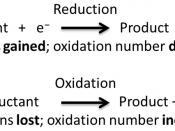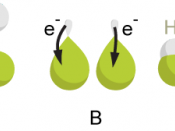Aim: To determine the rate law of chemical reactions
Introduction: The aqueous solution of potassium peroxydisulphate can oxidize potassium iodide as follow:
Equation:
K S 0 (aq) + 2KI (aq)->2K S0 (aq)+I (aq)
2 2 8 2 4 2
KI(aq) +I (aq) -> KI (aq)
2 3
_________________________________________________
K S 0 (aq) +3KI(aq) -> 2K S0 (aq)+ KI (aq)
2 2 8 2 4 2
The rate law of this reaction can be represented as follow:
Rate=k[S208 2-]^a [I-]^b
When the concentration of peroxydisulphate ions is fixed, the order of reaction with respect to iodide ion is formed.
Alos, when the concentration of iodide ion is fixed, the order of reaction with respect to peroxydisulphat can be found.
It is important to keep the same volume of solution in each trial. To determine the order of this reaction, the initial rate method is applied. This experiment is often known as the 'iodine clock' experiment.
Materials and apparatus:
1) 100cm3 beaker
2)burette
3)0.1M K2S208
4)0.1M KI
5)0.002M K2S208
6)starch
7)water
8)test tubes
9)stop watch
Precautions:
1) The stop watch should be started after the potassium peroxysulphate solution just mixed with potassium iodide.
2) Drawes a cross on a white paper that will be easier to observe the intensity of dark blue intensity.
Procedures:
1. KI,starch and sodium thiosulphate were mixed into a boiling tube following the table which was an attachment(Data treament).
2. The mixture was transferred to a 100cm3 beaker.
3. The exact amount of sodium peroxydisulphate was added in a boiling tube to the mixture in (2) as soon as possible. At the same time, the stop watch was stared.
4. The time for the solution to turn dark blue was recorded.
Data Treatment and the result and calculations:
Trial | 1 | 2 | 3 | 4 | 5 |
Volume of 2- 0.1M S208 | 10 cm3 | 10 cm3 | 10 cm3 | 9 cm3 | 8 cm3 |
Volume of 0.1M KI | 1.5 cm3 | 2.5 cm3 | 3.5 cm3 | 3.5 cm3 | 3.5 cm3 |
Volume of 2- 0.002M S203 | 5 cm3 | 5 cm3 | 5 cm3 | 5 cm3 | 5 cm3 |
Volume of starch | 2.5 cm3 | 2.5 cm3 | 2.5 cm3 | 2.5 cm3 | 2.5 cm3 |
Volume of water | 2 cm3 | 1 cm3 | 0 cm3 | 1 cm3 | 2 cm3 |
Concentration 2- [S208 ]0 | 0.048 moldm-3 | 0.048 moldm-3 | 0.048 moldm-3 | 0.043 moldm-3 | 0.038 moldm-3 |
Concentration [KI]0 | 0.0071 moldm-3 | 0.012 moldm-3 | 0.017 moldm-3 | 0.017 moldm-3 | 0.017 moldm-3 |
Time for blue appear | 812s | 570s | 430s | 525s | 581s |
Relative rate(1/T) | 0.00123 | 0.00175 | 0.00233 | 0.00190 | 0.00172 |
Because Rate=k[S208 ^2-]^a [I-]^b
0.00123=k [0.0048]^a[0.0071]^b-----------------1
0.00175=k [0.0048]^a[0.012]^b-----------------2
0.00233=k [0.0048]^a[0.017]^b-----------------3
0.00190=k [0.0048]^a[0.0071]^b---------------------4
0.00172=k [0.0038]^a[0.0071]^b----------------------5
1/2:
0.00123/0.00175=(0.0071/0.012)^b
0.70286=(0.59167)^b
log0.70286=b(log0.59167)
b=0.6719
2/3:
0.00175/0.00233=(0.012/0.017)^b
b=0.9461
1/3:
b=0.7317
3/4:
a=1.8545
4/5:
a=0.8054
3/5:
a=1.2985
Hence, a=(1.8545+0.8054+1.2985)/3
a=1.31 =1
b=(0.7317+0.9461+0.6719)/3
b=0.78 =1
So,the rate equation is RATE= k [S208 2-] [I-]
Discussion:
In this experiment, the overall of reaction is 2.
The use of sodium thiosulphate in this experiment is monitor the reactions becuse when the iodine colour(dark blue) disappear, it implies the thiosulphate is used up,too. I2 + S203^2-->2I- +S406^2-
But the result was not accurate enough because there were somethings cause the errors:
1 solution mixture was not mixing well enough
2 inaccuracy in judging the experiment by using our bare eyes.
3 hard to measure the end point in each trial which have the same colour intensity.
Accordins to the above errors, there were some improvements:
1 gently shake the mixture well
2&3 using calorimeter instead of using by bare eyes.


